Samsung has held its traditional January presentation of new flagship smartphones, including three models: Samsung Galaxy S24, Galaxy S24+, and Galaxy S24 Ultra. In addition, the company focused on its Galaxy AI platform, which is used in smartphones and should (theoretically) make it easier and more convenient to interact with a smartphone and perform basic everyday tasks. All the changes in the new smartphones are quite expected and there were no surprises or revolutions. Processors, cameras, and some other relatively minor changes have been updated. But while we at gg are waiting for samples for detailed reviews, we'll tell you about our first impressions of the new products.
What's new in the top-of-the-line Samsung Galaxy S24 Ultra?
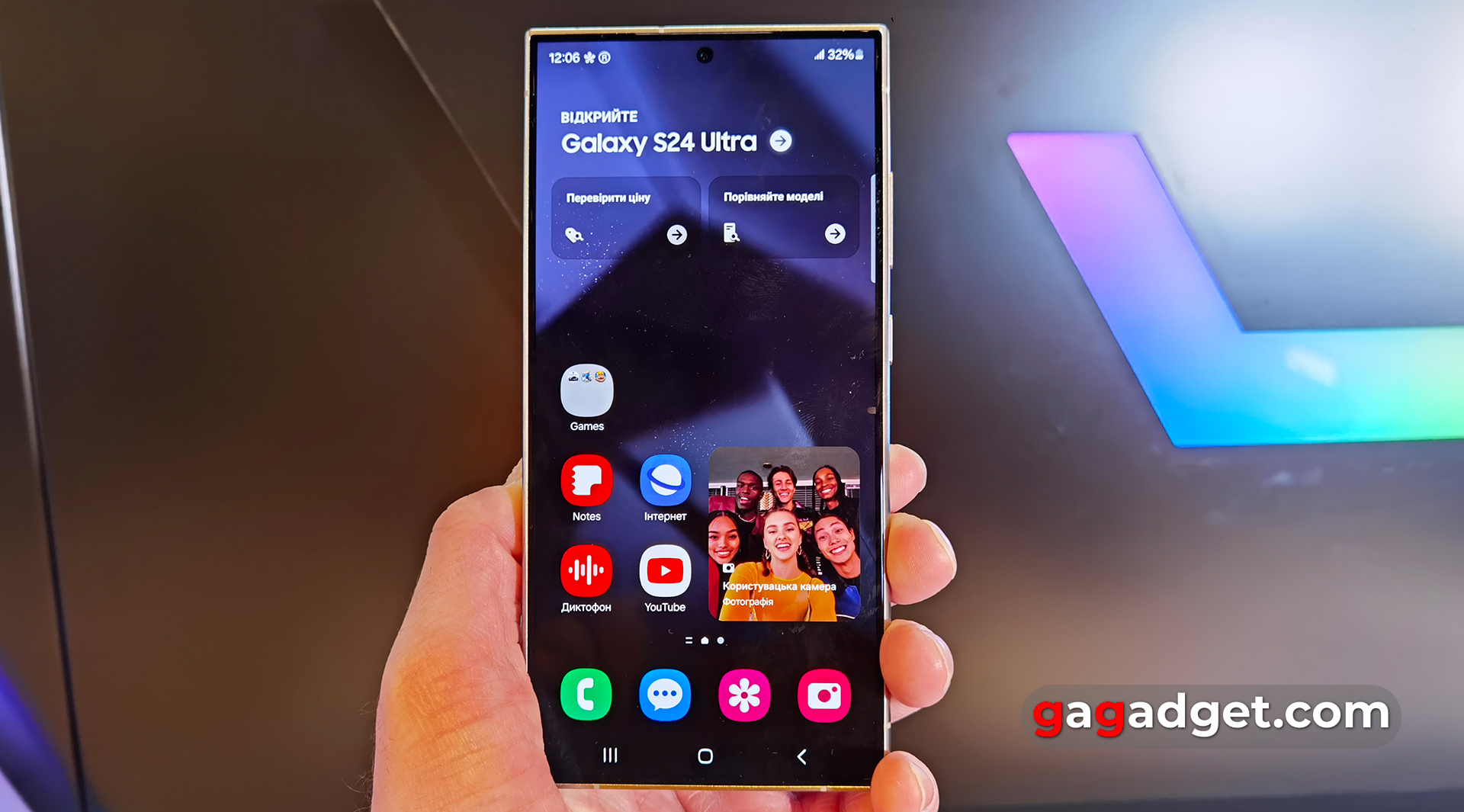
Samsung Galaxy S24 Ultra has received a number of innovations compared to its predecessor. First of all, these are the materials of the case: the frame, as expected, is made of titanium, and the front and back panels are made of the new Gorilla Glass Armour. The design hasn't changed much. Only the colour options are different, and the flat screen is now used, only the glass has subtle roundings around the perimeter. The electronic S Pen remains in place, with a shape with right angles and flat edges. Therefore, it will be possible to distinguish Samsung Galaxy S24 Ultra from S23 Ultra only in a close live comparison. The smartphone looks and feels nice and expensive. Although I still wanted some kind of more radical update.
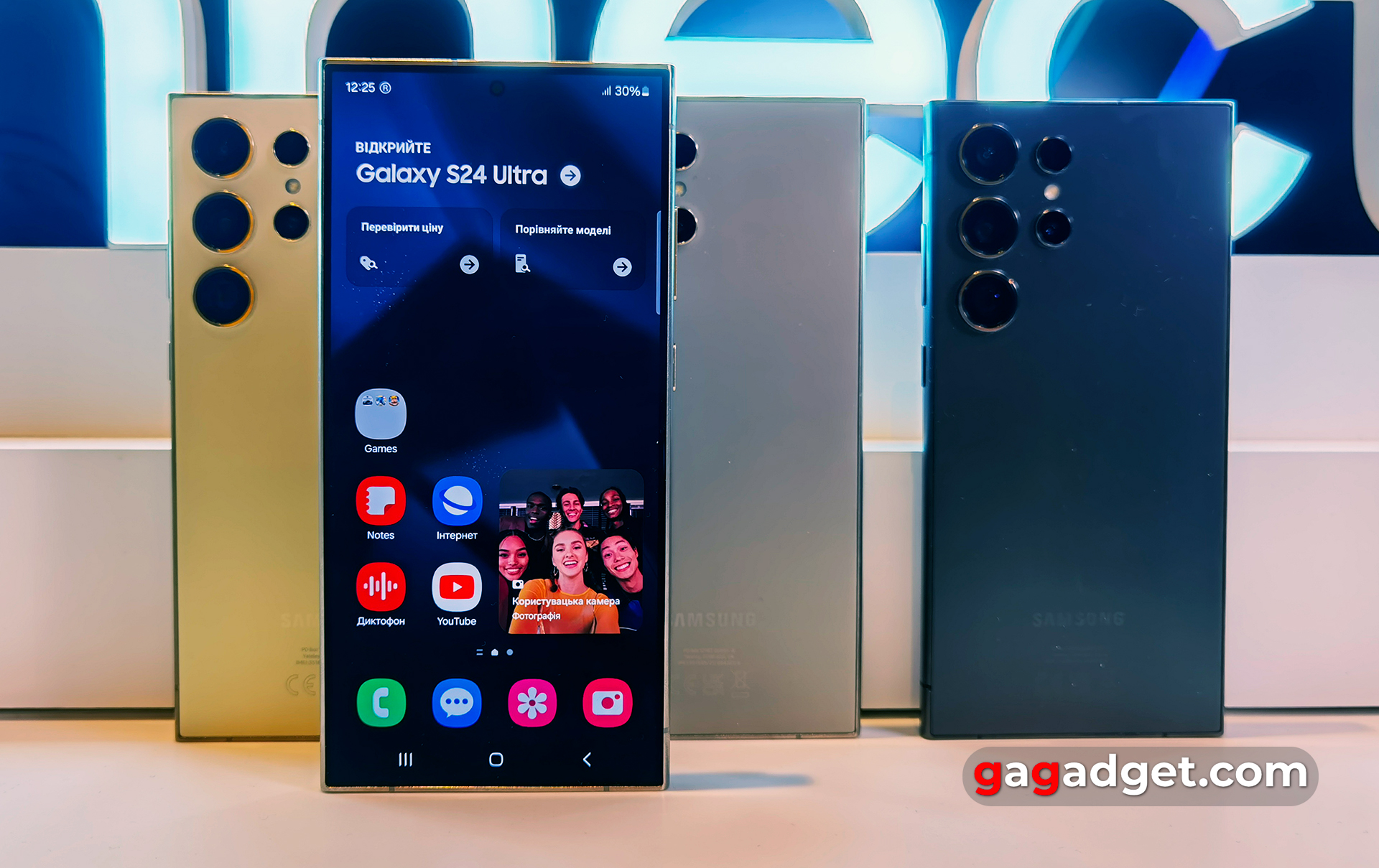
If we talk about the display, there are only two main differences from the previous model. These are the completely flat shape and increased brightness. Now they promise that the peak brightness is 2600 nits. The rest of the characteristics remain unchanged. The screen diagonal is 6.8 inches, using a Dynamic AMOLED LTPO 2X matrix with a resolution of 3088x1440 and an adaptive refresh rate of 1-120 Hz. The sensor reading frequency is 240 Hz. There is support for Dolby Vision and HDR10+ standards. All of Samsung's latest flagships have excellent quality screens, so the new Samsung Galaxy S24 is no exception. But, of course, we will conduct detailed tests in the gg editorial office during the reviews.
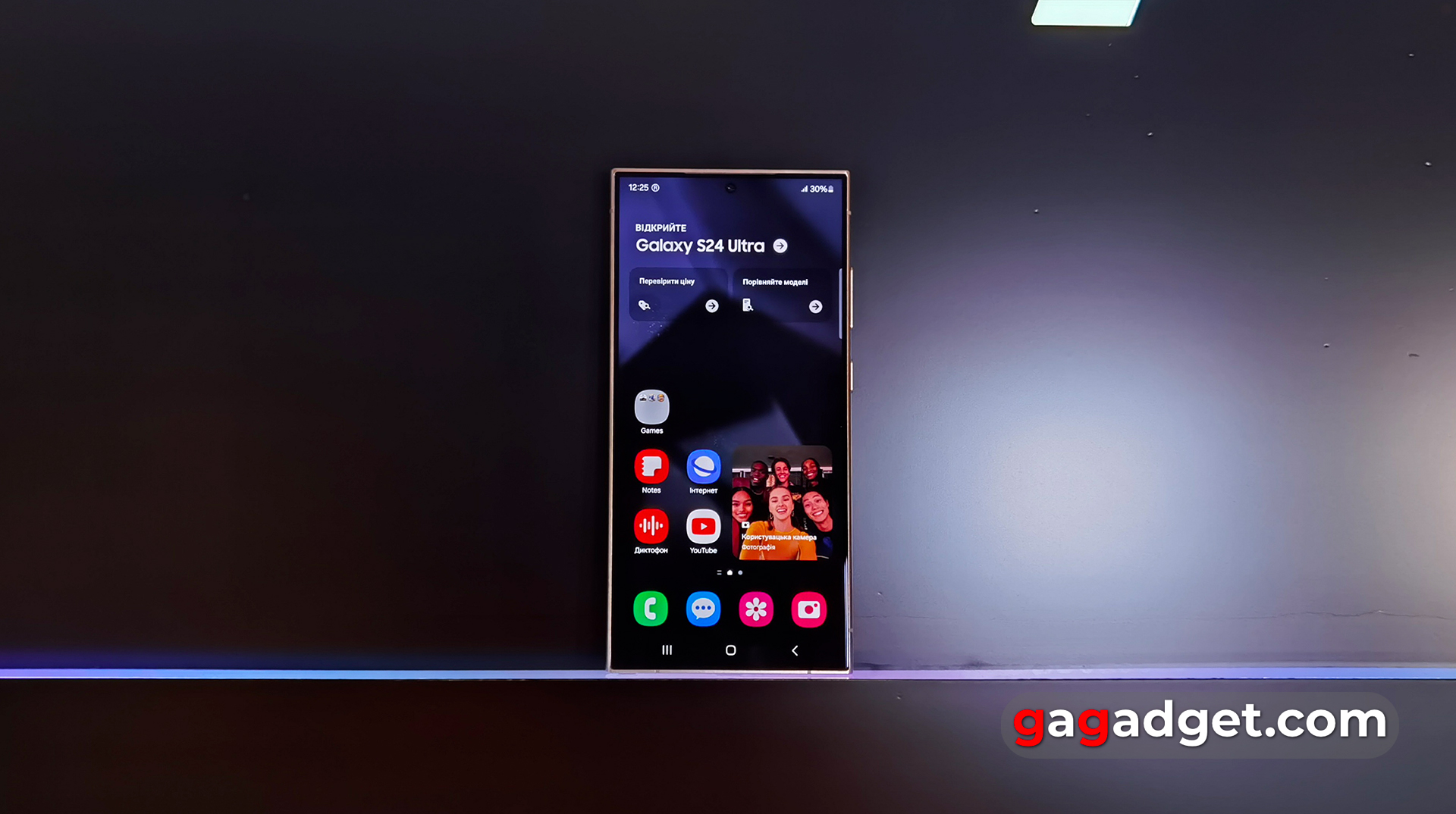
The rear camera unit also remained unchanged: separate modules that protrude quite strongly above the back cover. Subjectively, I would have liked to see a design with a common, albeit protruding, plane. Because dust immediately collects between the individual modules, and the frames of individual lenses can be damaged. The rear glass cover has a frosted finish and will be available in four colours. Black, grey, purple and yellowish gold. The most interesting and original is the purple one with a silver frame.
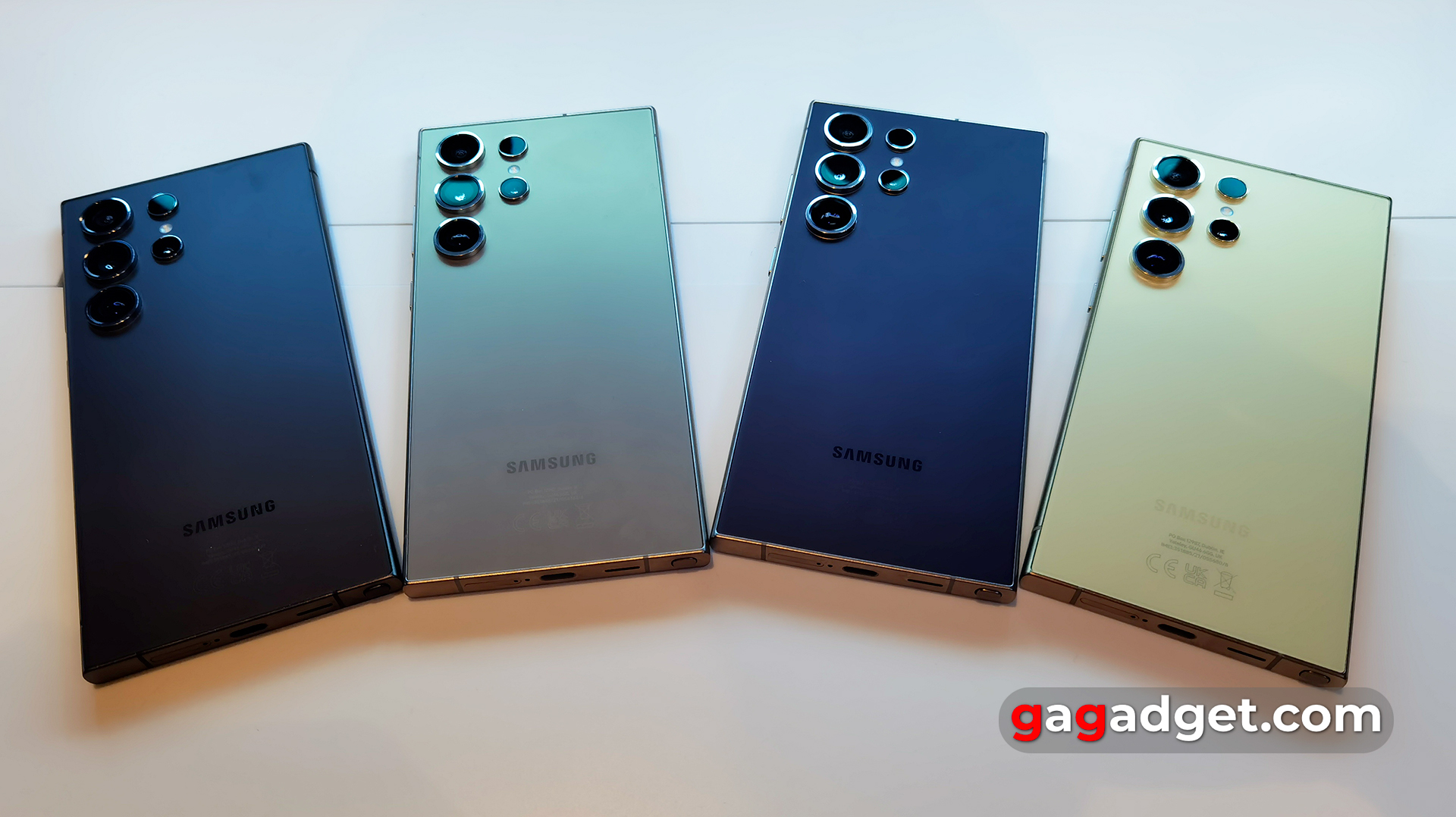
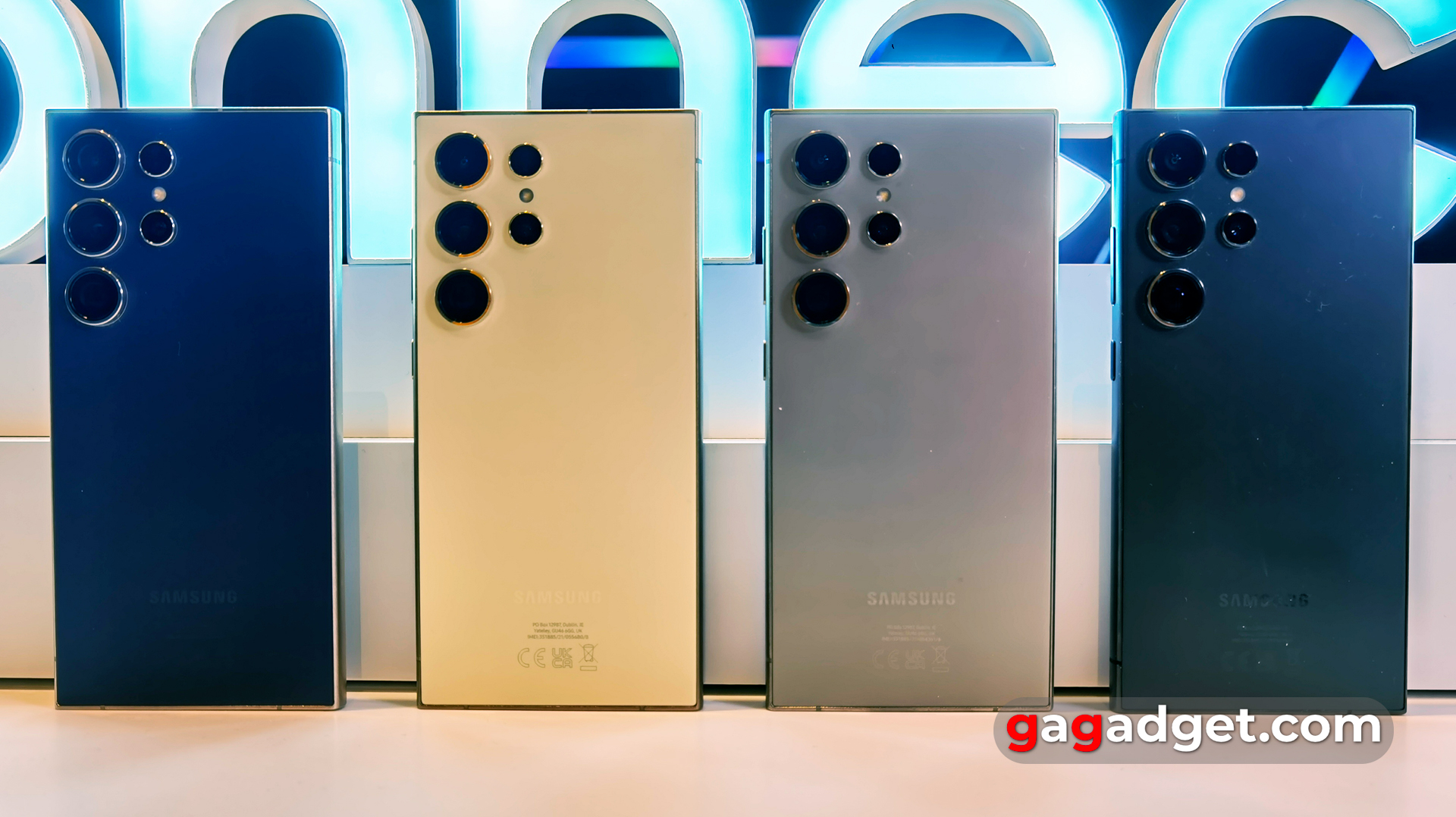
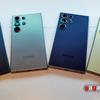

Many branded protective cases will be available. Some are particularly interesting. The case with a built-in handle that can be used as a stand has been especially updated. And the options developed with National Geographic. They have interchangeable pictures on the back and (it seems) an NFC tag. Thanks to which the screen saver on your smartphone will automatically change to the appropriate landscape.
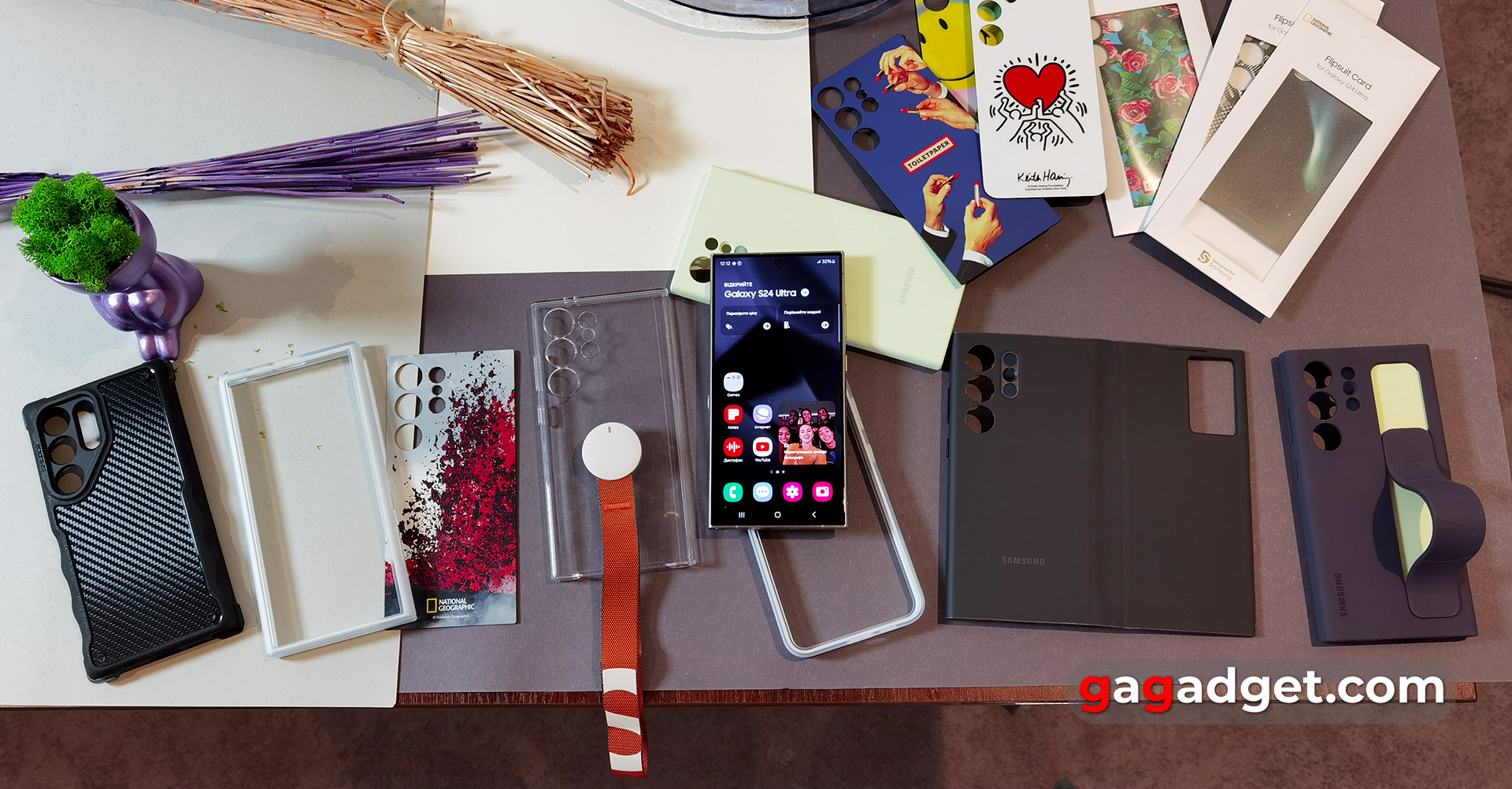
All the functional elements remained in their usual places, only the shape of the main speaker has formally changed. Instead of a series of small holes, there is now one wide slot. As before, Samsung Galaxy S24 Ultra is IP68 dust and water resistant and can theoretically withstand immersion in water to a depth of 1.5 metres for up to half an hour.


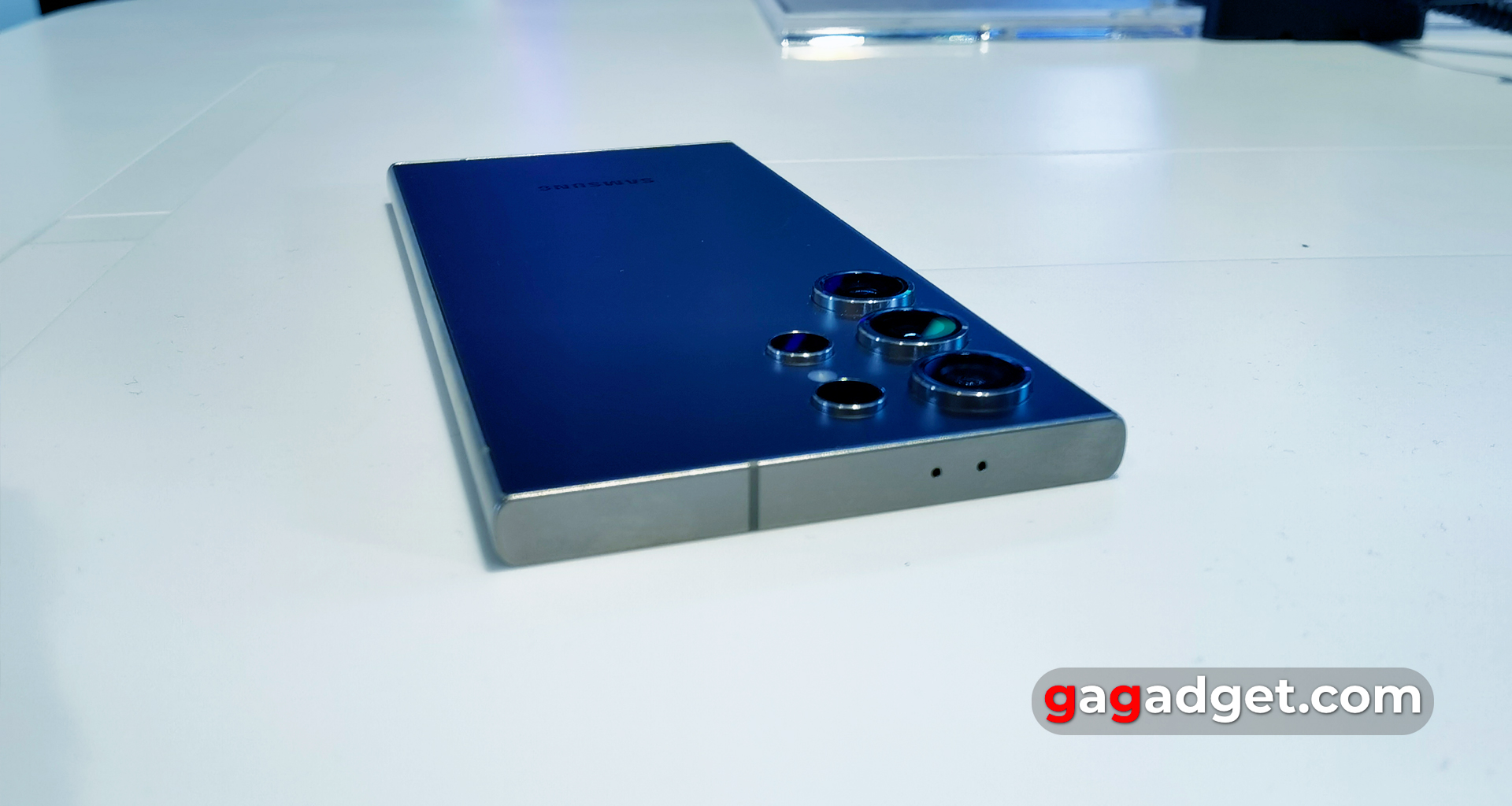
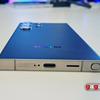
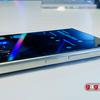
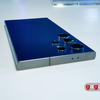
The situation with processors this year is interesting and may not appeal to potential buyers of the younger Samsung Galaxy S24 and Galaxy S24+: they received the flagship Samsung Exynos 2400 processor. But the Samsung Galaxy S24 Ultra is equipped with the latest top-of-the-line Qualcomm Snapdragon 8 Gen 3 octa-core processor with Adreno 750 graphics accelerator. It's too early to talk about the performance and optimisation of both processors, but we'll find out during the reviews. There is 12 GB of LPDDR5x RAM, and the internal storage can be 256/512 GB or 1 TB. The new high-speed UFS 4.0 memory is used. The battery capacity and charging speed remain unchanged: 5000 mAh, 45W wired charging and 15W wireless charging, as well as 4.5W reverse wireless charging for accessories. The smartphone runs on Android 14 with the proprietary One UI 6.0 shell.
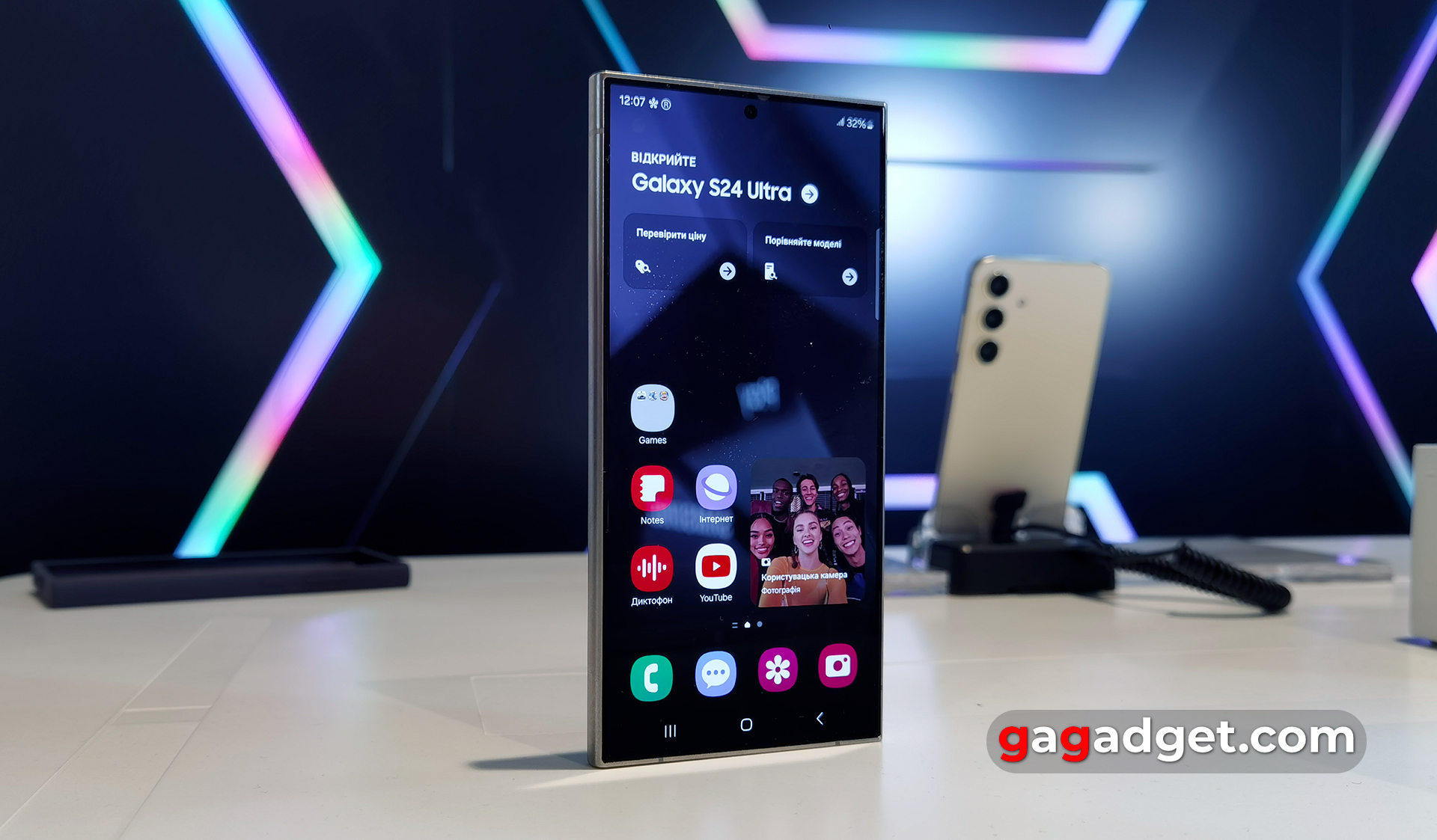
The configuration of the rear cameras remained almost unchanged. So we have four modules: the main one, a telephoto with a 3x zoom, a periscopic telephoto, and an ultra-wide-angle one. The periscopic telephoto module has changed: instead of a 10-megapixel module with 10x zoom, a 50-megapixel module with 5x zoom is now used. Samsung claims that the new module, even with a zoom of up to 10x, takes better photos than last year's. Returning to the other cameras, the main one has a resolution of 200 MP and takes photos with a resolution of 12.5 or 200 MP. There's a 3x 10MP telephoto and a 12MP ultra-wide-angle with phase detection autofocus.
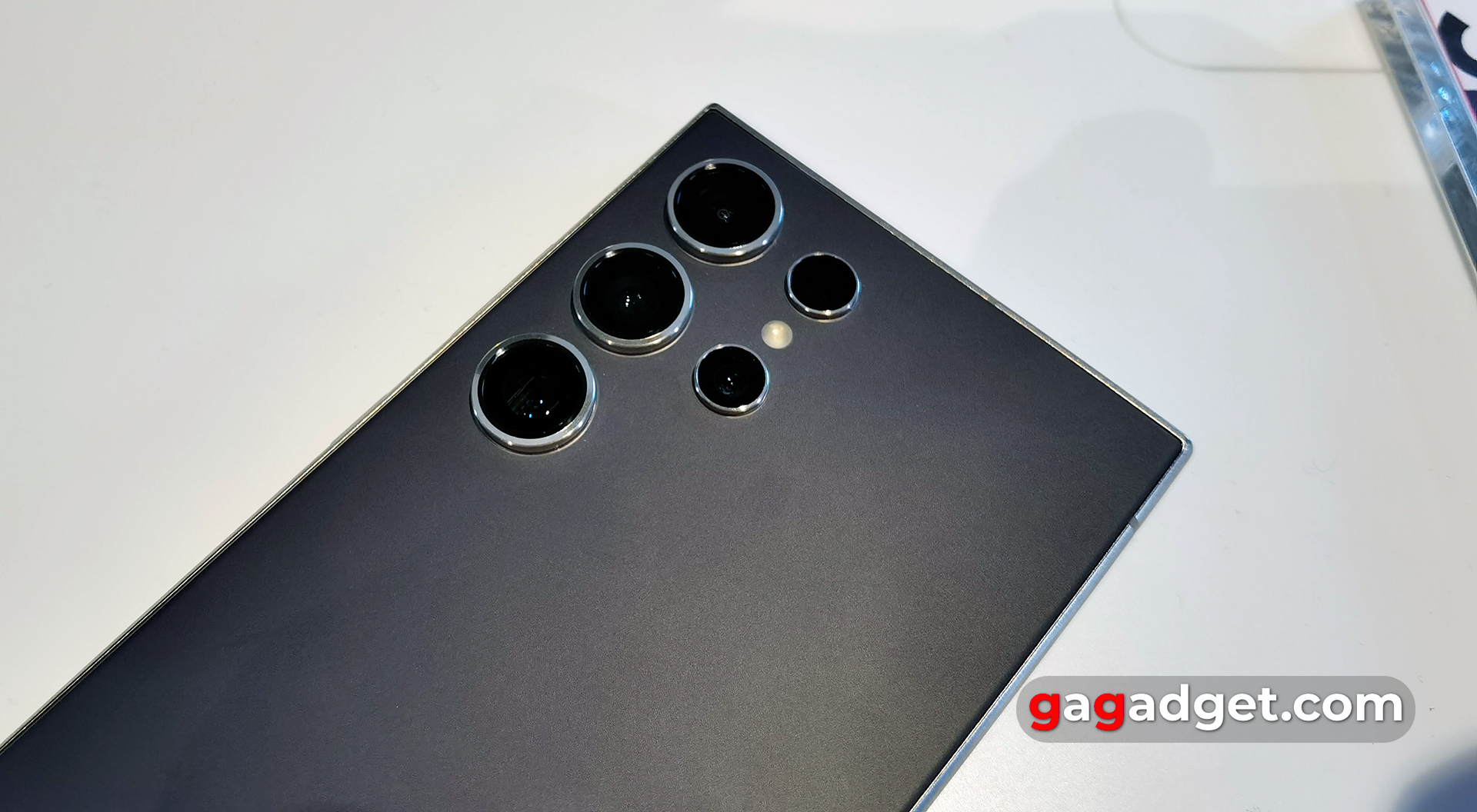
The S Pen remains in place and seems to be unchanged. It is equipped with Bluetooth LE, gyroscope and accelerometer. So it can be used not only for notes and drawing, but also as a remote control. Handwriting recognition is said to have improved.
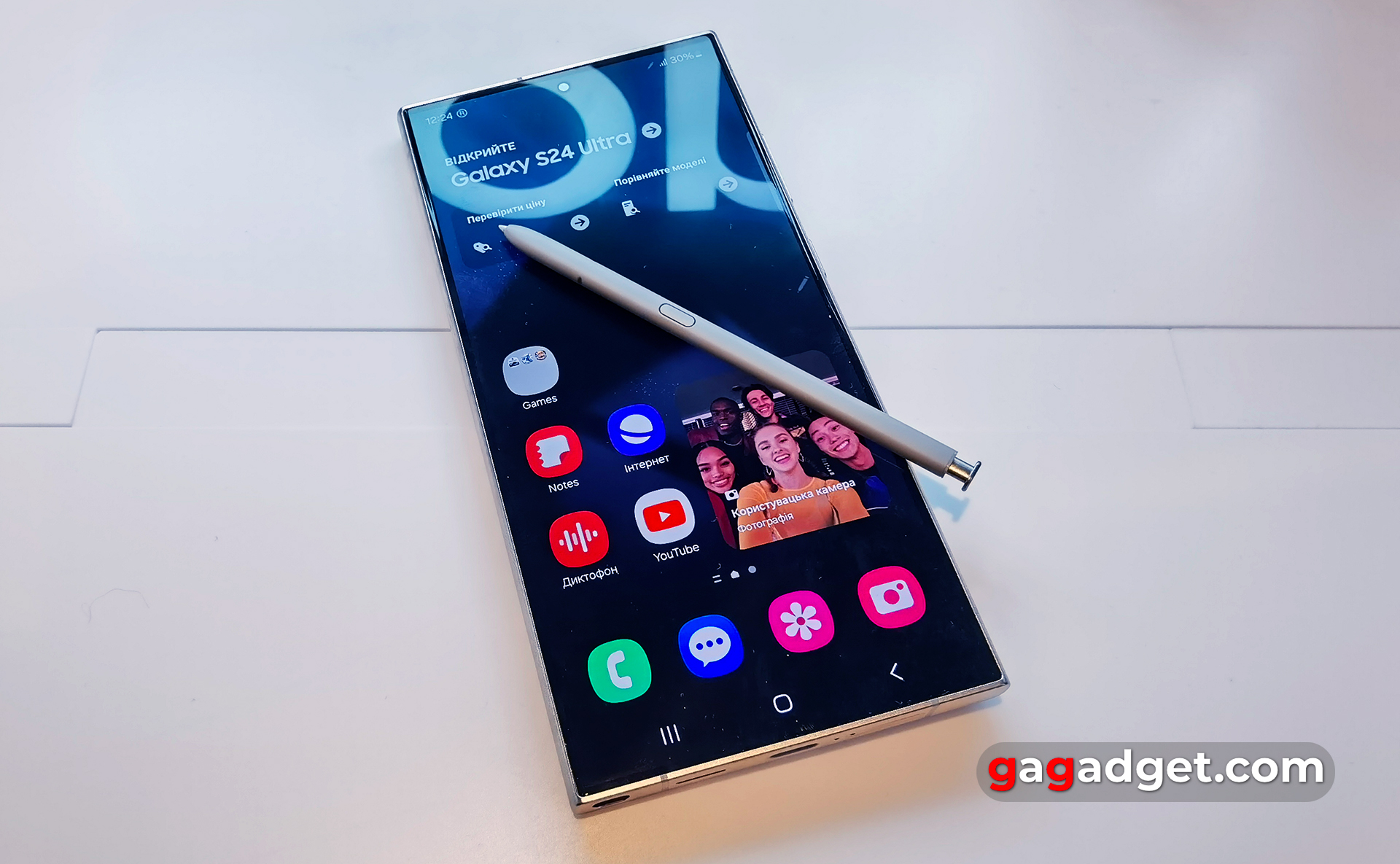
Comparison of the characteristics of Samsung Galaxy S24 Ultra and Galaxy S23 Ultra:
| Specifications | ||
|---|---|---|
| Samsung Galaxy S24 Ultra | Samsung Galaxy S23 Ultra | |
| Display. | Flat Dynamic LTPO AMOLED 2x, 6.8 inches, 3088x1440 (aspect ratio 20:9), 516 ppi, HDR10+, Dolby Vision, 1-120 Hz, Gorilla Glass Armour, peak brightness 2600 nits | Curved on the sides Dynamic LTPO AMOLED 2x, 6.8 inches, 3088x1440 (aspect ratio 20:9), 516 ppi, HDR10+, Dolby Vision, 1-120 Hz, Gorilla Glass Victus 2, peak brightness 1750 nits |
| Body. | No data | Dimensions: 163.4x78.1x8.9 mm, weight: 233 g |
| Processor. | 64-bit 4nm Qualcomm Snapdragon 8 Gen 3 Mobile Platform for Galaxy, 1x3.3 GHz Cortex-X4, 5x3.2 GHz Cortex-A720, 2x2.3 GHz Cortex-A520, Adreno 750 graphics, 1 GHz | 64-bit 4nm Qualcomm Snapdragon 8 Gen 2 Mobile Platform for Galaxy, 1x3.36 GHz Cortex-X3, 2x2.8 GHz Cortex-A715, 2x2.8 GHz Cortex-A710, 3x2.0 GHz Cortex-A510, Adreno 740 719 MHz graphics |
| RAM | 12 GB LPDDR5x | 8/12 GB |
| Flash memory | 256/512 GB/1 TB UFS 4.0 | 256/512 GB/1 TB UFS 4.0 |
| Camera | 200 MP (f/1.7, 23 mm EPS, 1/1.3", 0.6 µm, Dual Pixel PDAF, OIS); 50 MP periscopic telephoto (PDAF, OIS, 5x zoom); 10 MP telephoto (f/2.4, 70 mm, 1/3.52", 1.12µm, Dual Pixel PDAF, OIS, 3x zoom); ultra-wide-angle 12 MP (f/2.2, 13 mm, 120˚, 1/2.55", 1.4µm, Dual Pixel PDAF); flash, video 8K@30fps, 2160p@60fps, 1080p@240fps, 720p@960fps; front camera: 12 MP (f/2.2, 25 mm, PDAF) |
200 MP (f/1.7, 23 mm EPS, 1/1.3", 0.6 µm, Dual Pixel PDAF, OIS); 10 MP periscopic telephoto (f/4.9, 230 mm EPS, 1/3.52", 1.12µm, Dual Pixel PDAF, OIS, 10x zoom); 10 MP telephoto (f/2.4, 70 mm, 1/3.52", 1.12µm, Dual Pixel PDAF, OIS, 3x zoom); ultra-wide-angle 12 MP (f/2.2, 13 mm, 120˚, 1/2.55", 1.4µm, Dual Pixel PDAF); flash, video 8K@30fps, 2160p@60fps, 1080p@240fps, 720p@960fps; front camera: 12 MP (f/2.2, 25 mm, PDAF) |
| Wireless technologies | Wi-Fi 802.11 a/b/g/n/ac/6e/7 (tri-band), Bluetooth 5.3 LE, NFC | Wi-Fi 802.11 a/b/g/n/ac/6e (tri-band), Bluetooth 5.3 LE, NFC |
| GPS | GPS, A-GPS, GLONASS, BDS, GALILEO | GPS, A-GPS, GLONASS, BDS, GALILEO |
| Battery. | 5000 mAh, non-removable, 45W fast charging, 15W wireless charging, reverse wireless charging | 5000 mAh, non-removable, 45W fast charging, 15W wireless charging, wireless charging reverse |
| Operating system | Android 14 + One UI 6.0 | Android 13 + One UI 5.1 |
| Sim card | 2xNanoSIM | 2xNanoSIM |
| Additionally | S Pen, IP68 dust and water protection, ultrasonic in-screen fingerprint scanner, Samsung Wireless DeX | S Pen, IP68 dust and water protection, ultrasonic in-screen fingerprint scanner, Samsung Wireless DeX |
How interesting are the new Samsung Galaxy S24 and Galaxy S24+?
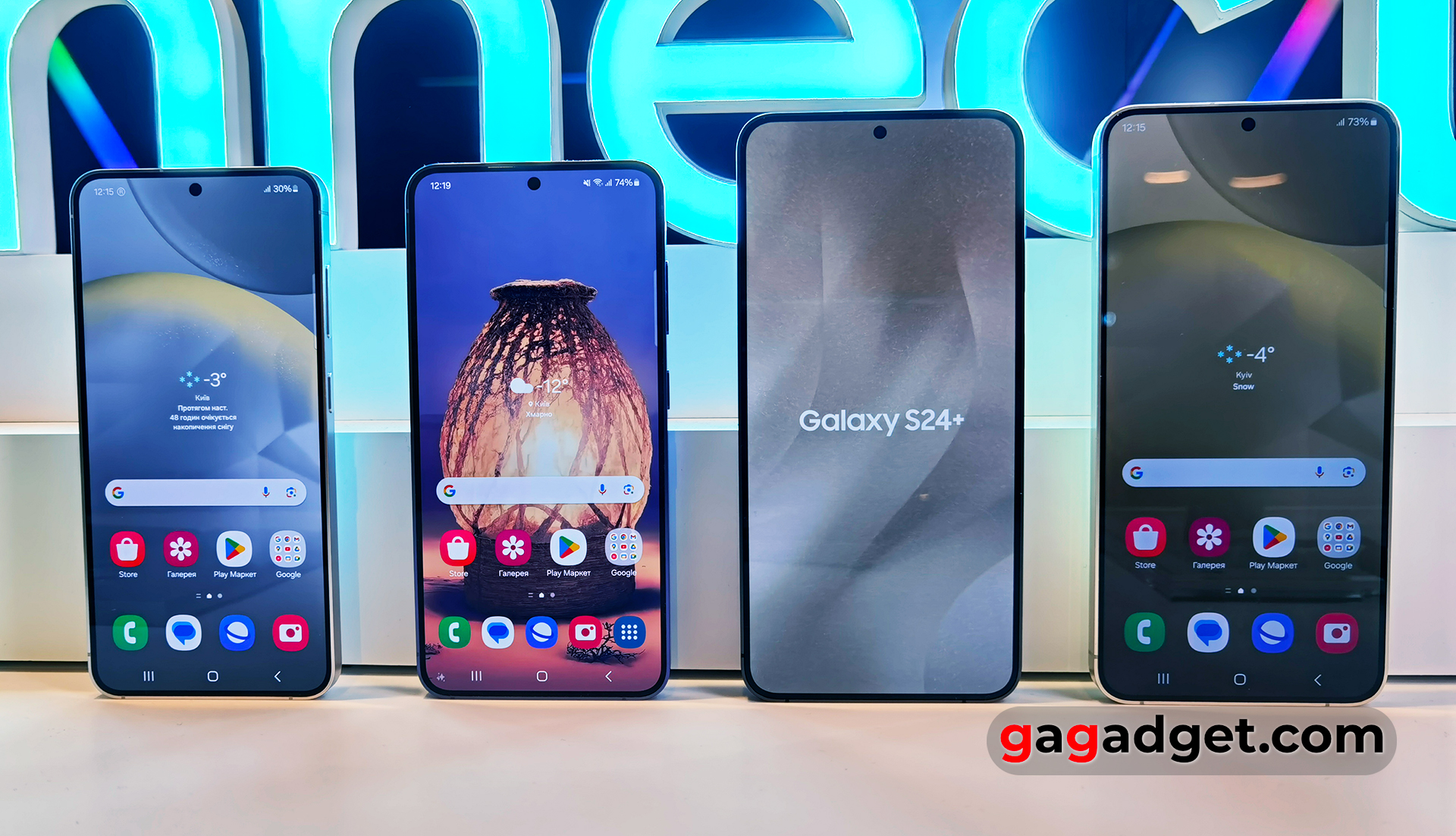
Externally, the Samsung Galaxy S24 and Galaxy S24+ remain almost unchanged, the difference with last year's lineup is minimal. The body shape is similar, with glass on the front and back, and an Armour Aluminium frame. But its edges have been made a little more streamlined, especially for the larger Samsung Galaxy S24+ model. In general, both models feel good in the hand, but the more compact Galaxy S24 still seems more comfortable. The colours are the same as the Ultra model, and the glass on the back is also matte. The dimensions have changed slightly compared to the Samsung Galaxy S23 and Galaxy S23+ due to slightly larger display diagonals.
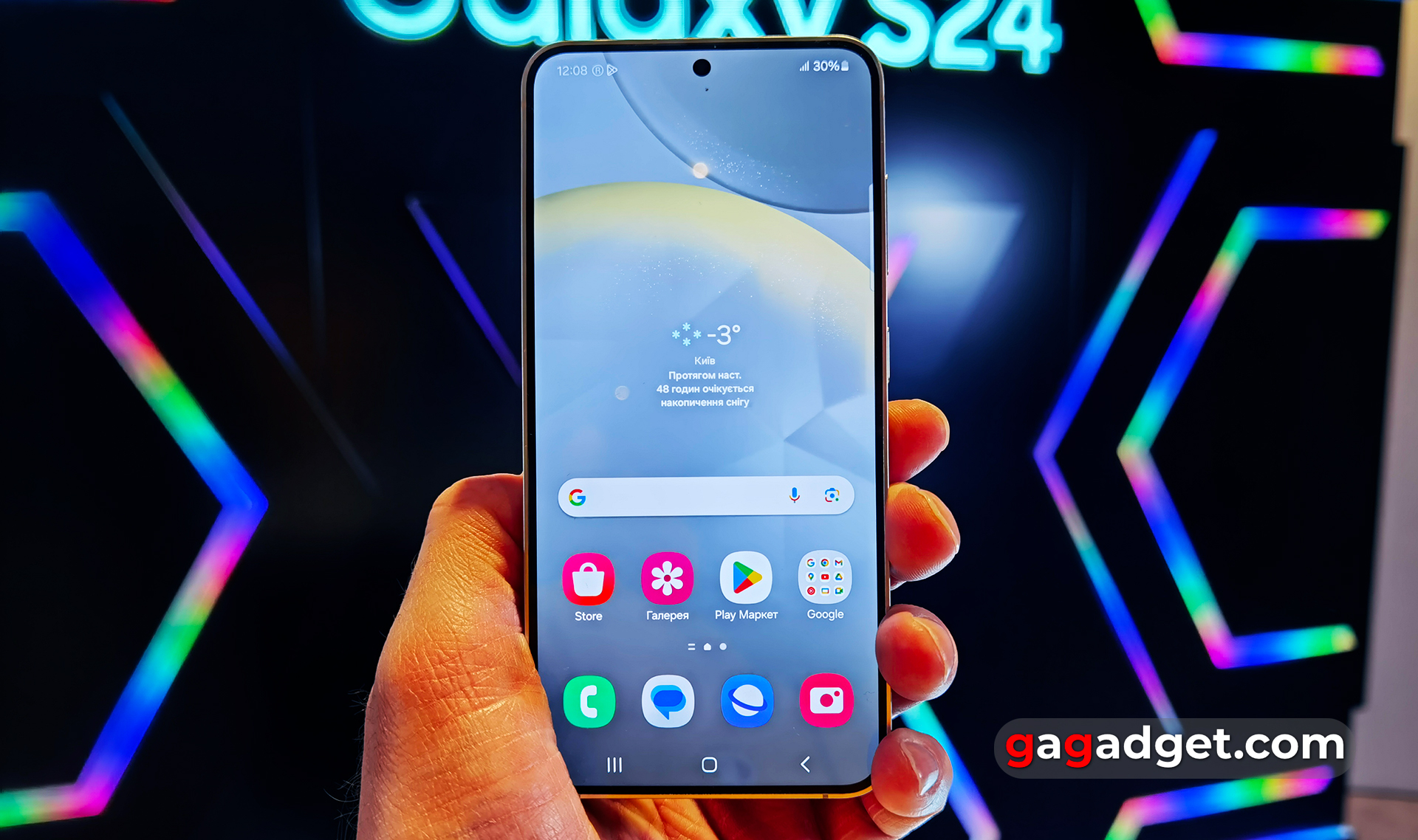
The Samsung Galaxy S24 has a 6.2-inch display (compared to the Galaxy S23's 6.1-inch), and the Galaxy S24+ has a 6.7-inch display (last year's plus had a 6.6). But the diagonal is not the only thing that has changed. Like the older model, the smartphones have Dynamic LTPO AMOLED 2-matrixes that support an adaptive refresh rate of 1-120 Hz. Last year, the frequency could vary in the range of 48-120 Hz. The peak brightness is declared at the same level as in Ultra: 2600 nits. There is support for HDR10+. This time, the display resolution is different. The Samsung Galaxy S24 has a 2340x1080 (FullHD+) screen, while the Galaxy S24+ has a resolution of 3088x1440 (QHD+).

As mentioned above, the younger models have a 10-core 64-bit processor of Samsung's own production, the Exynos 2400. The processor is manufactured on the basis of Samsung's new 4nm LPP+ process. It has an interesting configuration of 1+2+3+4 cores. There is one powerful Cortex-X4 core operating at up to 3.1 GHz, two Cortex-A720 cores at 2.9 GHz, three Cortex-A720 cores at 2.6 GHz and a block of four energy-efficient Cortex-A520 cores at 1.8 GHz. Graphics are handled by the Xclipse 940 accelerator based on AMD's RDNA 3 graphics architecture, which supports real-time ray tracing. The Exynos 2400 is said to have 1.7 times the processing power of the Exynos 2200. And in machine learning tasks, the difference is as much as 14.7 times. The previous Exynos 2200 was not very successful. However, it is claimed that the company has done a lot of work and the performance of the new Exynos 2400 is close to the top Qualcomm products. So it will be interesting to see what the new processor is capable of and how well it is optimised.
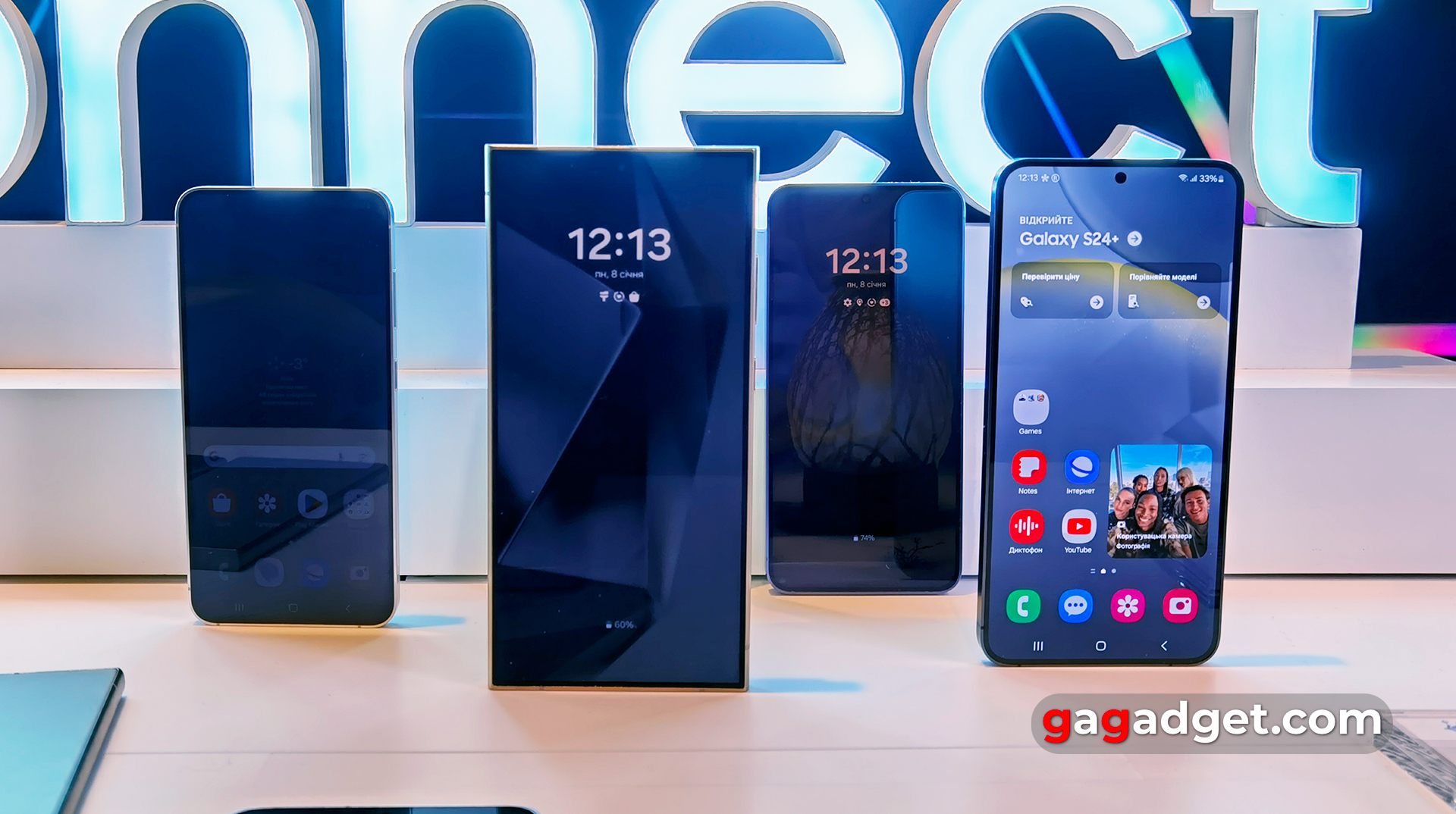
Samsung Galaxy S24 has 8 GB of RAM and variants with 128/256 GB of internal storage. To be honest, it seems like it's time to give up on the 128GB variant. Samsung Galaxy S24+ has 12 GB of RAM and 256 or 512 GB storage. Not only the diagonal of the displays has slightly increased, but also the battery capacity. Samsung Galaxy S24 has a 4000 mAh battery instead of 3900 mAh. And Samsung Galaxy S23+ has 4900 mAh instead of 4700. The larger model supports 45W fast wired charging, while the smaller model supports 25W. Both models also support 15W wireless charging and 4.5W reverse wireless charging for accessories. They run on Android 14 with One UI 6.0.
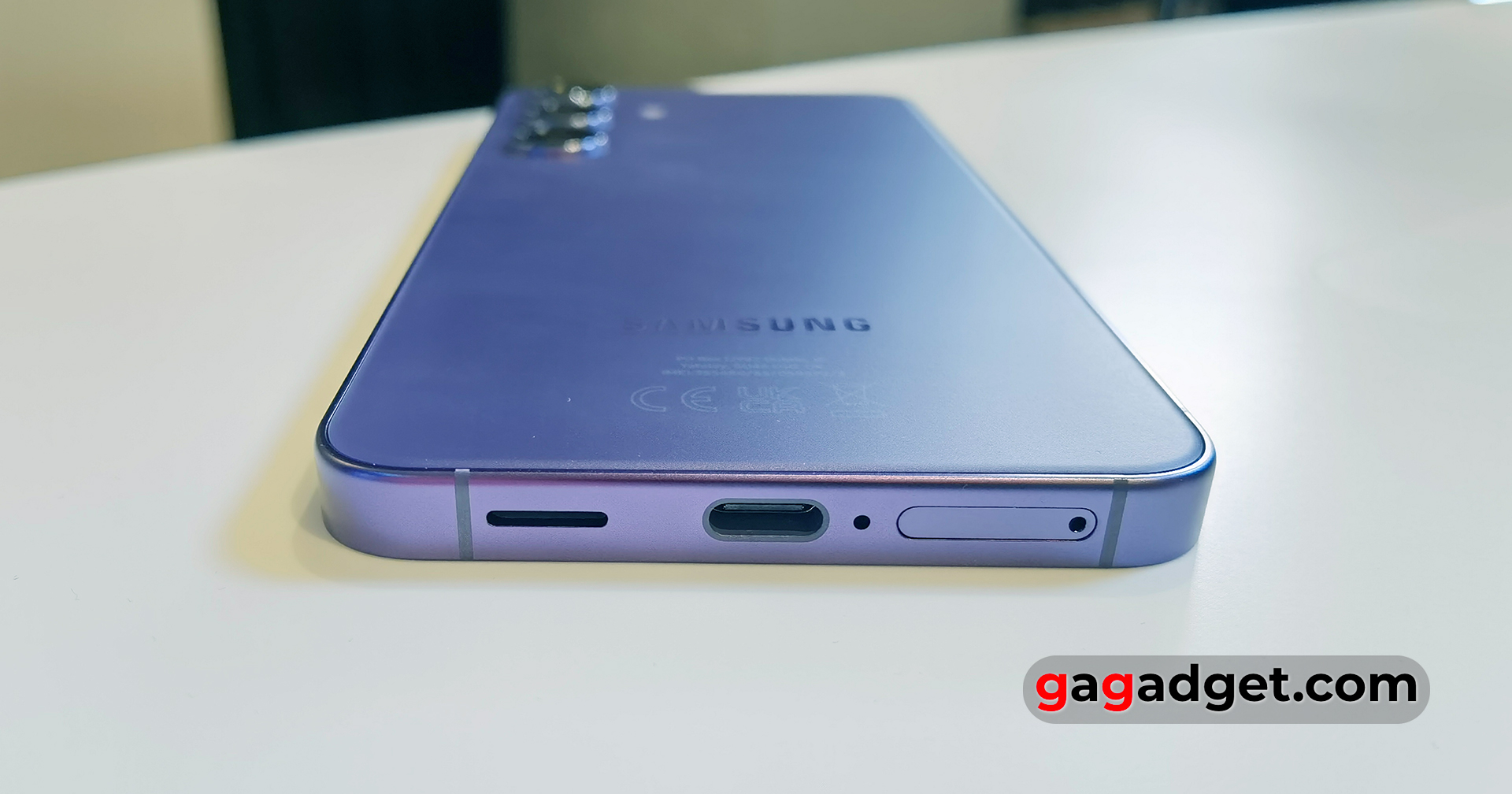

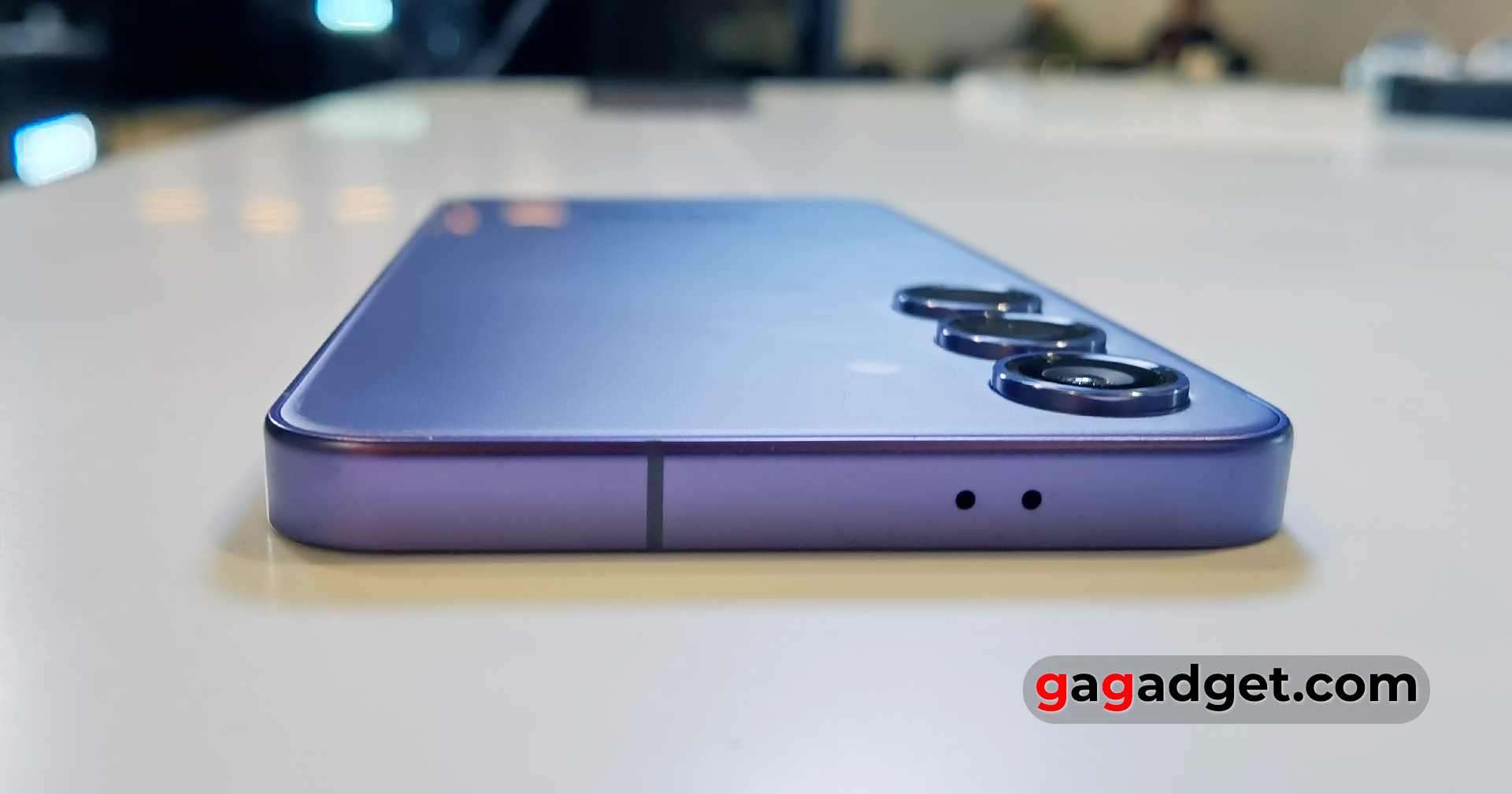
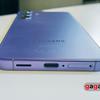
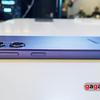
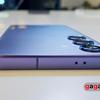
In terms of their main characteristics, the cameras of the new Samsung Galaxy S24 and Galaxy S24+ do not differ from the previous line. So there are three modules at the back. The main 50-megapixel camera with f/1.8 aperture, multi-directional PDAF and optical stabilisation, a 10-megapixel telephoto with f/2.4 aperture, PDAF, optical stabilisation and 3x zoom, and a 12-megapixel ultra-wide-angle camera with f/2.2 aperture, 120˚ viewing angle, again without autofocus. The front camera is 12 MP, f/2.2, 25 mm with phase detection autofocus. We'll see how well they shoot during the review, especially given the use of the Exynos 2400 processor.
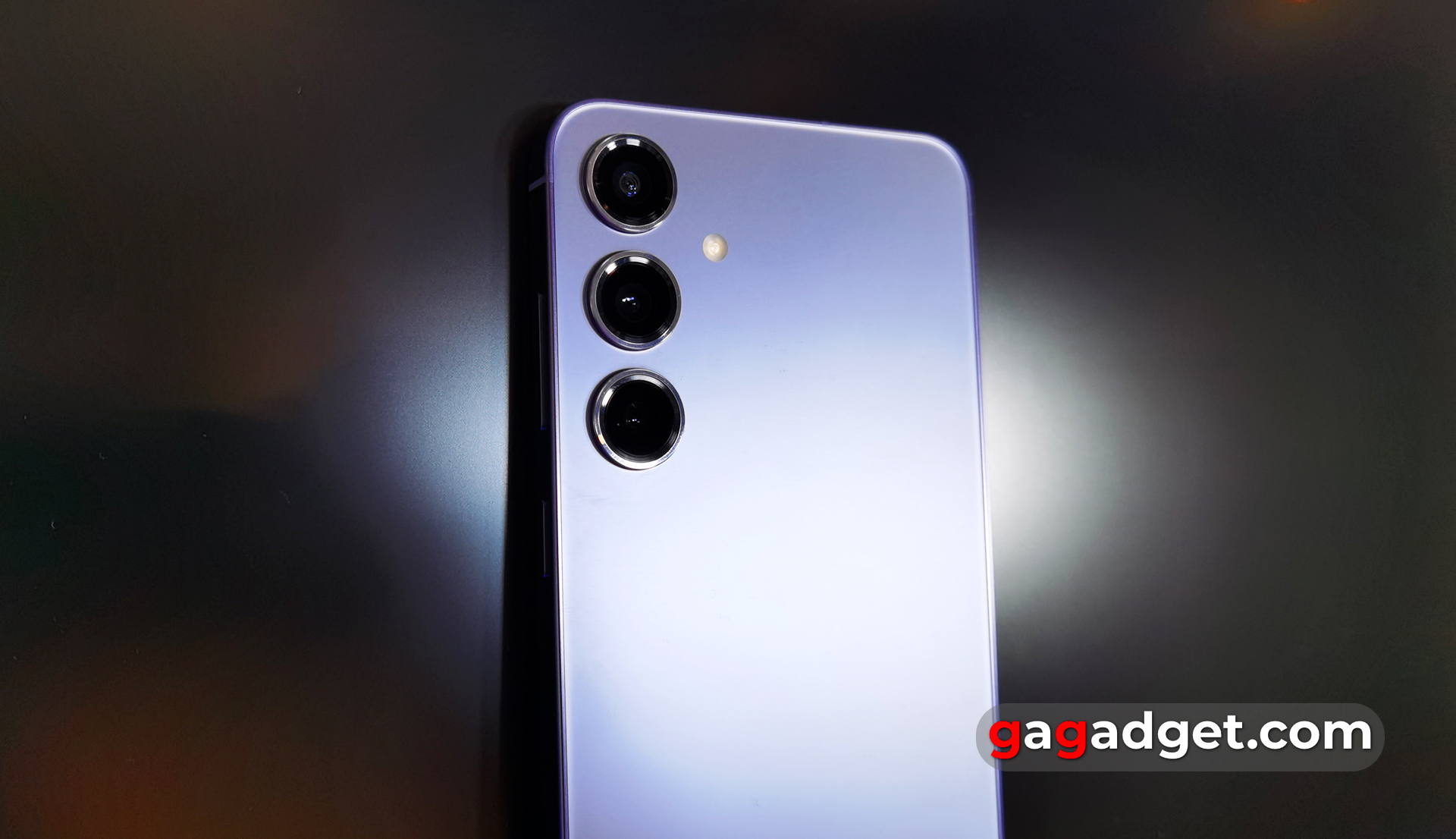
Smartphone specifications:
| Technical specifications | ||
|---|---|---|
| Samsung Galaxy S24 | Samsung Galaxy S24+ | |
| Display. | Dynamic AMOLED 2x, 6.2 inches, 2340x1080 (19.5:9 aspect ratio), 416 ppi, HDR10+, 1-120 Hz, Gorilla Glass Victus 3, 2600 nits | Dynamic AMOLED 2x, 6.7 inches, 3088x1440 (19.5:9 aspect ratio ), 509 ppi, HDR10+, 1-120 Hz, Gorilla Glass Victus 3, 2600 nits |
| Processor. | 64-bit 4nm Samsung Exynos 2400, 1x3.1 GHz Cortex-X4, 2x2.9 GHz Cortex-A720, 3x2.6 GHz Cortex-A720, 4x2.0 GHz Cortex-A520, Xclipse 940 AMD RDNA 3 graphics | 64-bit 4nm Samsung Exynos 2400, 1x3.1 GHz Cortex-X4, 2x2.9 GHz Cortex-A720, 3x2.6 GHz Cortex-A720, 4x2.0 GHz Cortex-A520, Xclipse 940 AMD RDNA 3 graphics |
| RAM | 8 GB LPDDR5x | 12 GB LPDDR5x |
| Flash memory | 128/256 GB UFS 3.1/4.0 | 256/512 GB UFS 4.0 |
| Camera. |
50 MP (f/1.8, 24 mm, 1/1.56", 1.0µm, multi-directional PDAF, OIS); telephoto 10 MP (f/2.4, 70 mm, 1/3.94", 1.0µm, PDAF, OIS, 3x zoom); ultra-wide-angle 12 MP (f/2.2, 13 mm, 120˚, 1/2.55" 1.4µm); flash, video 8K@30fps, 2160p@60fps, 1080p@240fps, 720p@960fps; front camera: 12 MP (f/2.2, 25 mm, PDAF) |
50 MP (f/1.8, 24 mm, 1/1.56", 1.0µm, multi-directional PDAF, OIS); telephoto 10 MP (f/2.4, 70 mm, 1/3.94", 1.0µm, PDAF, OIS, 3x zoom); ultra-wide-angle 12 MP (f/2.2, 13 mm, 120˚, 1/2.55" 1.4µm); flash, video 8K@24fps, 2160p@60fps, 1080p@240fps, 720p@960fps; front camera: 12 MP (f/2.2, 25 mm, PDAF) |
| Wireless technologies | Wi-Fi 802.11 a/b/g/n/ac/6e (tri-band), Bluetooth 5.3 LE, NFC | Wi-Fi 802.11 a/b/g/n/ac/6e (tri-band), Bluetooth 5.3 LE, NFC |
| GPS | GPS, A-GPS, GLONASS, BDS, GALILEO | GPS, A-GPS, GLONASS, BDS, GALILEO |
| Battery. | 4000 mAh, non-removable, 25W fast charging, 15W wireless charging, wireless charging | 4900 mAh, non-removable, 45W fast charging, 15W wireless charging, reverse wireless charging |
| Operating system | Android 14 + One UI 6.0 | Android 14 + One UI 6.0 |
| Sim card | 2xNanoSIM | 2xNanoSIM |
| Additionally | IP68 dust and water protection, ultrasonic fingerprint scanner in the screen, Samsung Wireless DeX | IP68 dust and water protection, ultrasonic fingerprint scanner in the screen, Samsung Wireless DeX |
So what about artificial intelligence?

Samsung focuses attention on the fact that artificial intelligence will be actively used in new products, the company calls it Galaxy AI. Although, in fact, it is more correct to use the term machine learning. This applies to many smartphone functions. Including the camera, browser, notes, and calls. There are plenty of useful features. Real-time translation during a voice call will be possible, which is useful for those who often communicate with people from other countries. The voice recorder will have the functions of transcription into text, translation into another language, and automatic creation of a kind of short summary with the main points. A similar feature will also be available in the company's browser. It will be possible not to read a large article in full, but to get a short summary with the most important points. Translation and spell checking will of course be available for text communication. In addition, you can set the tone of the message depending on the situation: casual, professional, polite, etc.













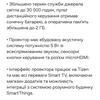
You may also find the feature of recognising objects in a photo useful. By launching the corresponding function and simply circling the object of interest in the picture, you can get all the available information about it. In general, of course, most of these features are hardly unique, as they are available in third-party applications. First of all, from Google. But in this case, it is interesting and important that all processing will take place directly on Galaxy S24 smartphones. The list of supported languages will be expanded gradually, so at launch, you should expect support for only the most common ones (English, Chinese, French, German, etc.).
To sum up.
This year, Samsung decided to focus on its new AI platform Galaxy AI at the presentation of the flagship Galaxy S24 line. It is supposed to significantly simplify and improve user interaction with smartphones, as well as provide access to many really useful features. Time will tell how effective and efficient it will be in use. As for the smartphones themselves, the improvements are not critical, but important. The older Samsung Galaxy S24 Ultra model has a titanium body, new glass, the latest flagship processor, and a slightly updated periscopic telephoto camera. The younger models have a slightly larger screen, a new processor, but from Samsung, and slightly larger batteries. All three models use new, brighter AMOLED LTPO matrices and run on the latest version of the proprietary One UI shell. We'll find out how it all works and how noticeable these improvements will be during testing.
